The pedal harp versus the cross-strung harp.
The origins of the cross-strung or chromatic harp goes back to Spain with the "harpa de dos ordenes" (16th — 17th Century - Barock music).
In 1894 Gustave Lyon – engineer and CEO at "Pleyel, Wolff & Cie" in Paris (famous piano manufacturers) – was encouraged by composers and conductors to build the harp without pedals. The construction of the harp without pedals looks simple though it's difficult to build.
The strings are attached on each side of the neck of the harp, on 2 rows or courses. The harp consists of 78 strings, divided in 2 sets of strings: 46 of them placed on the left side, 32 strings on the right side. In the middle they "cross" each other, hence the name. One set is tuned in a diatonic C major scale, the other is tuned pentatonically. Each string represents a note. The "chromatic" nature of the cross-strung harp represents the white and black keys of the piano.
More strings means that the 'footwork' with the pedals is no longer necessary — note that the pedals are used to shorten the strings. But on the other hand the strings of the cross-strung harp build up an enormous tension on the frame. This makes the construction so difficult. To obtain a strong frame Gustave Lyon started to use a metallic frame. His 'template' was the chromatic harp of Johann Heinrich Pape (1789-1875), a triangular-shaped harp.
Pro & contra!
The triangular frame in metal is a strong construction, it permits the strings to stay in tune for a long time, a problem many harpist had to deal with. Another advantage was the absence of noise caused by the pedals. Some even point out that the player can be better focused on the music regarding the lack of pedals.
The strings break less often, a result of the construction that doesn't manipulate the strings while playing.
Criticism came from some players with the arguement that the cross-strung harp is too heavy while most of the players are ladies. Another criticism was a technical sorrow: more strings demands another way of playing. Some musicians didn't want to 'upgrade'. Also, in those days of crisis an extra harp was (too) expensive for some orchestra.
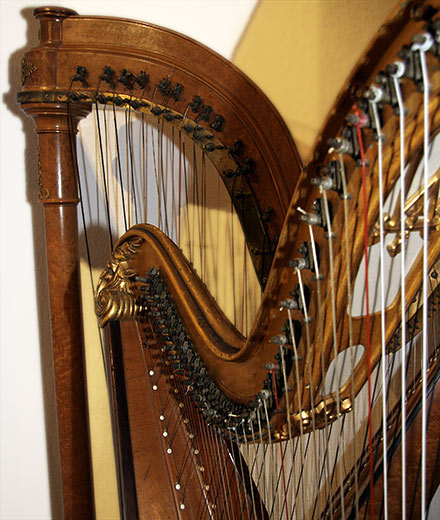
Pleyel & The harp | A brief history
Pleyel Company was founded in 1807 in Paris by the composer Ignace Pleyel
(1757-1831). Jean Henri Page, a famous English piano maker, joined the firm and
helped from 1811 to 1815. In 1815, Ignace’s son Camille Pleyel joined the firm, and
fourteen years later, Frédéric Kalkbrenner. Chopin made his debut in Paris in
February 26, 1832 at the Salle Pleyel and later owned an Pleyel grand piano (no.
7267) with a single escapement and a light touch. In 1855, Camille Pleyel died and the business passed to his son-in-law, Auguste Wolff(1821-1887).
The firm became Pleyel, Wolff & Cie. After Wolff’s death, his son-in-law, Gustave Lyon (1857-1936), joined the development of the chromatic harp…
[from: Margaret Cranmer “Pleyel” in The New Grove Dictionary of Music and Musicians, ed. Stanley
Sadie, 2nd ed, (London: Macmillan, 2001) vol. 19, 923-924.]
Obvious links :
Wikipedia — The Cross-strung harp
Wikipedia — The harp
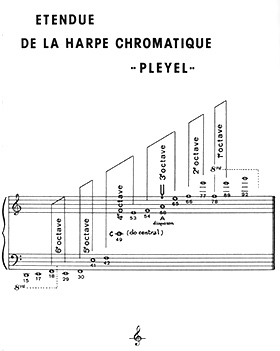
↑∗ excerpt from "Approche de la Harpe Chromatique" by Odile Tackoen

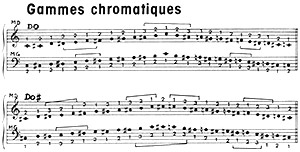
↑∗ excerpt from "Approche de la Harpe Chromatique" by Odile Tackoen
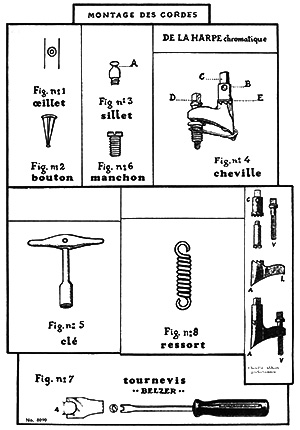
↑∗ excerpt from "Approche de la Harpe Chromatique" by Odile Tackoen
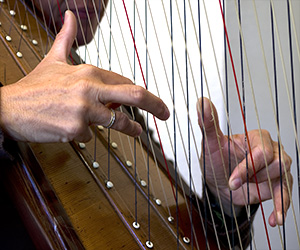
Odile Tackoen - Francette Bartholomée
After the death of Myriam Moens in 1953 Odile Tackoen became the teacher in the Music Academy of Schaerbeek, untill 1986. But in the Conservatoire the study of the chromatic harp was abandoned. Paola Chatelle was the first pupil of Francette Bartholomée for the chromatic harp after a long time...
In 1986 she followed up Odile Tackoen in the Academy...
My first meeting.
In 1900 the “Conservatoire Royal de Bruxelles“ started with the study of the chromatic harp under the wings of Jean Risler. Followed by another school in Brussels in 1922 under the direction of Germaine Cornélis, followed by Myriam Moens (°1904—†1953).

↑∗ excerpt from "Approche de la Harpe Chromatique" by Odile Tackoen
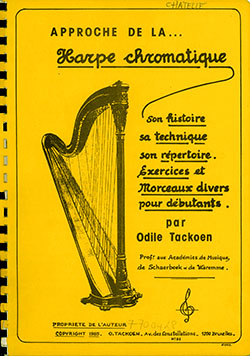
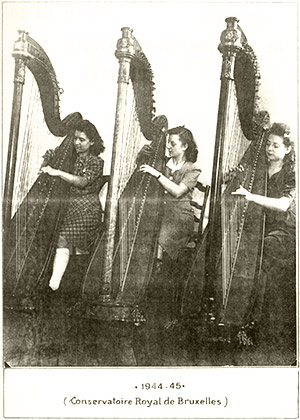
↑∗ excerpt from "Approche de la Harpe Chromatique" by Odile Tackoen
Webdesign © JP Van den waeyenberg | vandenwaeyenberg@telenet.be